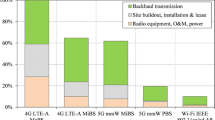Abstract
Municipalities can form a driving force behind the deployment of new telecom infrastructure. While a telecom operator focuses on direct (financial) profits, a municipality is mainly interested in the social benefits for its inhabitants. In this paper, we evaluate a wireless municipality network from both a technical and an economic point of view. WiFi and WiMAX are considered as the most suited technologies for this purpose. A detailed techno-economic study has been performed including forecasting of the user adoption, dimensioning of the wireless network and modelling the related costs and revenues. The trade-off between installing a high number of relatively cheap WiFi access points, and a smaller number of more expensive WiMAX base stations for delivering full coverage is investigated in several scenarios.
Similar content being viewed by others
References
Point topic. World Broadband Statistics Q2 2008. September 2008.
Verbrugge, S., Casier, K., Van Ooteghem, J., & Lannoo, B. (2008). Practical steps in techno-economic evaluation of network deployment planning. Presented at Networks 2008, 13th international telecommunications network strategy and planning symposium (tutorial T12), Budapest, Hungary, September 2008.
IEEE P802.11n/D3.00. (2007). Draft amendment to IEEE standard for information technology— Telecommunications and information exchange between systems—local and metropolitan area networks—specific requirements, part 11: Wireless LAN medium access control (MAC) and physical layer (PHY) specifications: Enhancements for higher throughput, September 2007.
IEEE Std. 802.16-2004. (2004) IEEE standard for local and metropolitan area networks, part 16: Air interface for fixed broadband wireless access systems, October 2004.
IEEE Std. 802.16e-2005. (2006). Amendment to IEEE standard for local and metropolitan area networks, part 16: Air interface for fixed broadband wireless access systems—Physical and medium access control layers for combined fixed and mobile operations in licensed bands, February 2006.
WiMAX Forum. (2002). Simulation results for subchannelization, November 2002.
IEEE Report 802.11-03/845r1. (2003). Receiver sensitivity tables for MIMO-OFDM 802.11n, November 2003.
Biglieri, E., Goldsmith, A., Muquet, B., & Sari, H. (2007). Diversity, interference cancellation and spatial multiplexing in MIMO mobile WiMAX systems. In IEEE mobile WiMAX symposium (pp. 74–79), Orlando, USA.
Nuaymi, L. (2007). WiMAX: Technology for broadband wireless access. Wiley, January 2007.
Clearwire Belgium. http://www.clearwire.be.
Belgium Institute for Postal Services and Telecommunications (BIPT). http://www.bipt.be.
COST 231 Final Report. (1999). Digital mobile radio towards future generation systems. COST Telecom Secretariat, Brussels.
Erceg, V., Greenstein, L. J., Tjandra, S. Y., Parkoff, S. R., Gupta, A., Kulic, B., Julius, A. A., & Bianchi, R. (1999). An empirically based path loss model for wireless channels in suburban environments. IEEE Journal on Selected Areas in Communications, 17(7), 1205–1211.
Joseph, W., & Martens, L. (2006). Performance evaluation of broadband fixed wireless system based on IEEE 802.16. IEEE Wireless Communications and Networking Conference (WCNC2006), 2, 978–983.
ECC Report 33. (2003). The analysis of the coexistence of FWA cells in the 3.4–3.8 GHz band, May 2003.
Leung, K. K., Clark, M. V., McNair, B., Kostic, Z., Cimini, Jr., L. J., & Winters, J. H. (2007). Outdoor IEEE 802.11 cellular networks: Radio and MAC design and their performance. IEEE Transactions on Vehicular Technology, 56(5), 2673–2684.
WiMAX Forum. (2006). Mobile WiMAX—Part 1: A technical overview and performance evaluation, June 2006.
ETSI, TR 102 377 v1.1.1. (2005). Digital video broadcasting (DVB); DVB-H implementation guidelines, February 2005.
European Parliament. (2008). Telecoms package: More competition and improved consumer rights. Information Society—Press Release, August 2008. http://www.europarl.europa.eu/pdfs/news/expert/background/20080827BKG35492/20080827BKG35492_en.pdf.
Communication from European Commission to the European Parliament, the Council, the European Economic and Social Committee and the Committee of the Regions. (2007). Reaping the full benefits of the digital dividend in Europe: A common approach to the use of the spectrum released by the digital switchover. Brussels, November 2007. http://ec.europa.eu/information_society/policy/ecomm/doc/library/proposals/com_dd_en.pdf.
Gillett, S. E., Lehr, W. H., & Osorio, C. (2004). Local government broadband initiatives. Telecommunications Policy, 28, 537–558.
European Commission. (2007). State aid decisions—NN 24/2007—Prague Municipal Wireless Network, 24 April 2007. http://ec.europa.eu/comm/competition/state_aid/register/ii/doc/NN-24-2007-WLWL-en-30.05.2007.pdf.
Ballon, P. (2007). Changing business models for Europe’s mobile telecommunications industry: The impact of alternative wireless technologies. Telematics and Informatics, 24(3), 192–205.
Gregg, J. V., Hassel, C. H., & Richardson, J. T. (1964). Mathematical trend curves: An aid to forecasting. Edinburgh: Oliver & Boyd.
WiMAX Forum. (2004). Business case models for fixed broadband wireless access based on WiMAX technology and the 802.16 standard, October 2004.
Author information
Authors and Affiliations
Corresponding author
Rights and permissions
About this article
Cite this article
Van Ooteghem, J., Lannoo, B., Casier, K. et al. Municipalities as a Driver for Wireless Broadband Access. Wireless Pers Commun 49, 391–414 (2009). https://doi.org/10.1007/s11277-009-9695-2
Received:
Accepted:
Published:
Issue Date:
DOI: https://doi.org/10.1007/s11277-009-9695-2





